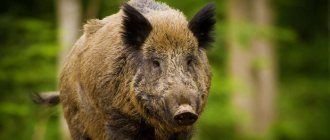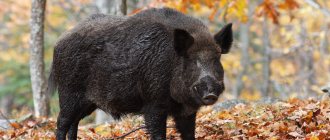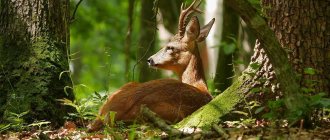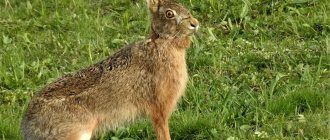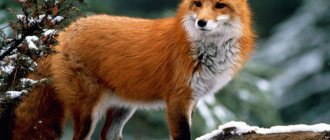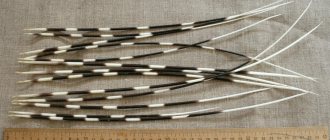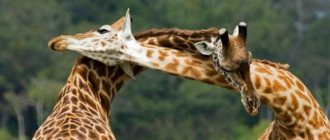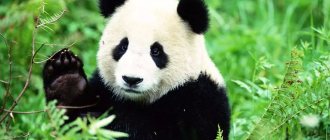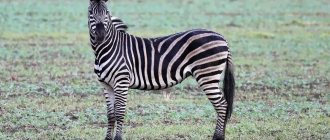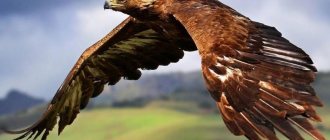- Difference from a pig
The wild boar is the direct ancestor and close relative of the well-known domestic pig, an animal domesticated by man back in the distant Stone Age. It is believed that the wild boar, which was the least afraid of people among animals and often came to “visit”, was tamed second after the dog. And over the centuries, it has become so deeply integrated into human culture, albeit under the guise of a pig, that it even became one of the symbols of the year according to the Chinese horoscope. And by the way, our site sincerely congratulates all readers on the upcoming 2022 year of the pig or wild boar, which is what our article is about today.
Description, structure, characteristics
So, the wild boar is a cloven-hoofed animal belonging to the suborder Porciniformes, the family of pigs. Also known as boar or wild pig. Although the wild boar is the ancestor of the domestic pig, nevertheless, in a number of ways it is strikingly different from it; we will write about the differences between the wild boar and the pig in more detail a little further.
The boar's body, covered with coarse hair, has a dense and muscular structure. Typically, adult boars grow up to one and a half meters in length, and the weight of a boar, depending on its fatness, can range from 60 to 300 kg. Males are usually larger than females. Interestingly, during the winter, additional fluff appears on the boar’s body, which prevents the animal from freezing. Also, our hero, like any decent artiodactyl, has a tail, although the boar’s tail is very short and small.
The boar's head is elongated, wedge-shaped. The ears are erect and large. Also, wild boars, especially males, have large fangs above and below, which gives them a very menacing appearance and makes these animals really dangerous, including to humans.
Boars' vision is not their strong point; by human standards, boars suffer from myopia. However, poor eyesight is more than compensated for by excellent hearing and sense of smell.
Typically, boars are grayish or brown in color, and they sometimes exhibit a phenomenon called acromelanism, when the face, tail and legs are painted black, and the rest of the body has brown or grayish shades. Sometimes there are wild boars with a lighter and even reddish color.
But small piglets up to one and a half years old are colored differently from adult wild boars; their fur is an alternation of stripes of brown, yellow and light colors. Thus, thanks to their color, they practically merge with the environment and become unnoticeable to predators, in such a simple way that nature took care of their protection and safety at a more vulnerable young age.
Popular message topics
- The works of Alexandre Dumas
The French author of famous novels, journalist and playwright Alexandre Dumas was born in 1802 in the small town of Villers-Cotterets. He grew up in a military family, his father was General Thomas-Alexandre Dumas, - Nonmetals
Nonmetals are special chemical elements. Until recently, these elements were called metalloids. They differ in that due to the small radius of the atom, as well as the presence of three or more negative - Carl Linnaeus
In this work we will try to explore the life and scientific discoveries in the field of biology, one of the greatest scientists Carl Linnaeus. The main achievements of Carl Linnaeus are considered his profound scientific works on classification
Difference from a pig
The wild boar and the pig are close relatives, coming from the same zoological branch, belonging to the same suborder of pig-like animals, but in the process of centuries of evolution, the domestic pig and the wild boar still acquired a number of differences:
A clear difference between a wild boar and a pig is shown in this photo, on the left is a pig, on the right is a wild boar.
Boars are not the best parents
Males do not show parental care because they are polygynous and live alone. And in females of this species, maternal care is worse than in sheep, goats and cattle.
Each litter averages from 4 to 6 piglets. In spring, a litter can have up to 10 piglets. Newborns weigh from 0.4 to 0.8 kg. For the first two weeks, the female is almost constantly with her cubs. At about two months of age, piglets begin to leave the nest for food.
Photo: www.thepigsite.com
Males stay with their mothers for up to a year and then leave the sonar forever. They usually only join the echo sounder during mating season. Female piglets, even after reaching maturity, usually remain in the same groups in which their mothers live.
To protect offspring within the sounder, females work together. During migration, mothers keep their young in the middle while the adults walk ahead and behind. The young often stay with one female while the rest of the group forages for food.
Habitats
Where does the wild boar live? In past times, wild boars lived in many places in Europe, Asia, and Africa, but now, unfortunately, in many places these animals have been completely exterminated. The most widespread European wild boar lives in forests from northern Europe to China. Wild boars can also be found in Africa. And wild boars were brought to America and Australia by Europeans.
Wild boars prefer forested areas as habitats; they especially love coniferous-deciduous forests. However, there are species of wild boars that also live in steppe areas.
Abundance of food in autumn
Acorns and nuts are a favorite delicacy of wild boars. These fruits contain a large amount of fat and protein, which allows the animal to quickly get enough. Wild boars feel especially comfortable in autumn in oak forests. By autumn, numerous rodents with offspring appear. They become easy prey for wild boars.
Often, in search of food, these animals pay visits to the gardens of summer residents and villagers. At this time, they become a real disaster, destroying vegetable gardens. Root vegetables and cabbage, as well as their tops and worms, which are found in abundance in the garden soil, are destroyed by the wild boar family without a trace.
Nutrition
What does a wild boar eat? Being an omnivore and having a formidable appearance, the wild boar still prefers various plant foods: acorns, root vegetables, berries and mushrooms. In winter, during a shortage of plant food and, moreover, cold weather, wild boars switch to a more satisfying diet; they can eat carrion, bird eggs, and larvae found on the ground and under the bark of some trees. By eating these larvae, which are often pests of trees, wild boars bring great benefits to the forest.
An adult boar eats up to 6 kg of food per day, and they also need a large amount of water. When coming to a river or lake to drink, wild boars are not averse to eating fish.
Lifestyle
This animal does not see very well, but it has a well-developed sense of smell. He can smell a person at a distance of four hundred meters. Strong smells often scare away the animal and disrupt the hunt.
Basically, wild boars live in herds. They include females with offspring from the previous year. The adult boar leaves him and lives alone. He comes to the herd for the mating period, and at this time takes on the role of leader. Wild boars are active at night, when they go out to get food and take water treatments.
During the day, he usually rests in swamps or in reeds, hiding in bushes. The habits of the wild boar are quite interesting. Animals are sensitive to sudden temperature changes. To avoid sunburn and protect themselves from insect bites, they carefully smear their entire body with mud. This is probably why an important condition for their comfortable living is the presence of a body of water near the rookery.
Boars try to keep a respectful distance from people. They rarely approach populated areas, but they regularly make forays into fields where corn or oats grow. The habits of wild boars do not change in winter. He moves little because it is difficult for him to move in deep snow.
Enemies in nature
In turn, wild boars can become a delicacy for larger predators. In our latitudes, the main natural enemy of wild boars is
wolf. Packs of wolves are very willing to hunt these animals, although it is worth paying tribute to wild boars, often adult individuals do not just give up without a fight. Possessing impressive and sharp fangs, the wild boar is quite capable of fighting back, and indeed there are cases when wolves themselves died from the fangs of wild boars.
In hotter countries, wild boars also fall prey to even more dangerous predators:
tigers, leopards, and in Africa the most dangerous enemy of the wild boar is the lion.
And of course, many wild boars have died and are being killed by human hunters and poachers.
Danger to humans
Yes, quite dangerous. But only if you are a hunter and are trying to shoot him or if there is a threat to his cubs. So, the wild boar is a peace-loving animal and will never be the first to attack a person. But a wounded boar is a completely different matter; from a good-natured bumpkin, he instantly turns into a real monster with burning eyes. An angry, wounded boar charging at a person is quite capable of terrifying even experienced hunters. And sometimes such a hunt can end very badly for the hunters themselves; there are cases when people died from the fangs of such an angry boar while hunting.
Boar hunting, medieval miniature.
Therefore, we urge you, if you are planning to hunt a wild boar, then let it be exclusively a photo hunt.
Piglets have a high mortality rate
At birth, piglets have very little fat and minimal energy reserves. By producing more young, females increase the chances of some offspring surviving. Sows with large litters have been known to accidentally crush their offspring. However, research suggests that this may be a deliberate action aimed at increasing the chances of survival of the rest of the litter. Reduced competition between piglets for feeding is a result of smaller litter sizes. Weaker piglets may try to feed several times before they are beaten by other young animals and simply die from malnutrition.
Females that farrow around the same time may allow piglets from another litter to nurse. However, more often sows refuse other people's piglets.
Types, photos and names
There are many different types of wild boars in nature; below we will describe the most interesting of them:
European boar
The European wild boar is the most common of the wild boars. It could also be called the common wild boar. Everything that we wrote about wild boars primarily concerns the European wild boar.
Warthog
Surely we all remember from childhood the bright hero from the Disney cartoon “The Lion King,” a warthog named Pumbaa. A characteristic feature of a real warthog is the presence of subcutaneous fat deposits on the face, reminiscent of warts themselves, hence the name of this boar. Also, the tusks of a warthog are more curved than those of a common boar. Lives in Africa.
River brush-eared pig
Found in central Africa, the brush-eared pig flaunts its colorful outfit. Its fur is bright red and there is a white stripe on its back.
bearded pig
A very interesting subspecies of wild boar or wild pig is the bearded pig, which lives in the mangrove forests of Indonesia. It differs from its relatives in its more athletic build and relatively small size, so the weight of a bearded pig does not exceed 50 kg.
Reproduction
The mating season for wild boars occurs at different times, depending on climatic conditions; in our latitudes it is usually autumn. At this time, male boars begin active courtship of females, sometimes real skirmishes occur between them, as a result of which the strongest boar gets the female.
The pregnancy of a female boar usually lasts 115 days, and from 3 to 10 small piglets can be born at a time. The first days of their lives, piglets (or young boars) are under the full care of their mother, staying in a cozy improvised “nest” that the boar has prudently prepared for them. Then, having matured a little and become stronger, they and their mother return to the herd.
Little piglets follow their mother everywhere and feed on her breast milk for up to three to four months. Then they begin to gradually mature and after a year and a half, female wild boars become sexually mature. But males mature a little longer; they become sexually mature only at 5-6 years.
Boars exhibit a polygynous mating system
Each male defends his mating rights with his fangs. The winning male pursues estrous females, encouraging them to show interest. If the female is interested in mating, she should urinate in response. If she doesn't, the male usually gives up mating after a few minutes.
Photo: www.news.sky.com
Boars are ready to breed at any time of the year. But the mating season depends on the climate, which directly affects the availability of food. If the females' nutritional needs are not met, the reproductive instinct may be suppressed. Females become reproductively mature at approximately 10-12 months of age, and males at two years of age.
Sows are prolific and can produce up to two litters per year. The estrous cycle usually lasts from 21 to 23 days. The gestation period of a sow ranges from 108 to 120 days. When sows are preparing to give birth, they will temporarily leave the sonar and return with their babies after farrowing. The young are born in a nest made of leaves, grass and moss.
Interesting Facts
- Since ancient times, hunting wild boars has been both dangerous and honorable. Sometimes in our time they hunt wild boars with dogs, as in ancient times, but instead of a spear they use firearms.
- In Europe, the boar is one of the main heraldic animals; for example, it was depicted on the coat of arms of Richard III, King of England.
- The herd of wild boars is dominated by females, the ratio is such that there are three females per male, since many old male wild boars prefer to lead a solitary lifestyle.
The domestication of wild boars began 10,000 years ago
Wild boars are widespread throughout Eurasia. According to zoo-archaeological evidence, namely bones and teeth, the domestication of these mammals began about 9-10 thousand years ago in the territory of modern Eastern Turkey. Several thousand years later they were also domesticated in Central China. According to a recent study comparing the DNA of wild boars and domestic pigs, domestication of these animals also occurred in other regions of the Old World, including Europe.
Video
And in conclusion, an interesting documentary about wild boars - “The Boar is a Born Fighter.”
Author: Pavel Chaika, editor-in-chief of Poznavaika magazine
When writing the article, I tried to make it as interesting, useful and high-quality as possible. I would be grateful for any feedback and constructive criticism in the form of comments on the article. You can also write your wish/question/suggestion to my email [email protected] or Facebook, with respect, the author.
Author page
